
How to Write an Email to a Teacher: The Ultimate Guide [+ Expert Tips and Templates]
How to write an email to a teacher:
-
- Ensure you have a good reason for emailing.
- Use their school email account.
- Choose the right time to email a teacher.
- Craft a detailed subject line.
- Greet a teacher respectively.
- Be concise and clear
- Format your email for better readability
- Be polite and show gratitude
- Label any attached files properly
- End an email with your full name, class, and institution

In today’s social media messengers era, many students lose writing skills and have no idea how to email a teacher. But still and all, this form of communication remains essential:
In the post-COVID world of distance learning and online classes, emailing teachers is a sign of good manners, a channel for submitting essays and other assignments, and a chance to resolve any educational issues officially.
This article is your ultimate guide on how to write an email to a teacher. Try to remember and follow the tips mentioned here, and you won’t have to blush for your writing mistakes and low manners anymore.
Table of Contents:
When It’s OK and Not OK to Email a Teacher
Emailing teachers is a formal procedure, so you shouldn’t burden them with dozens of messages every time you have a common question about a paper’s due date or general information about the course. Before you decide to email a professor, check the following information sources:
- the course syllabus
- the FAQ section of your teacher’s online discussion board (if they have any)
- the assignment description
The big chances are that you’ll find answers to your question there and won’t need to email a teacher. Teachers deal with many students and get dozens of emails daily, so why bother them with issues you can solve yourself?
And yet, there are some good-enough reasons when an email is a must. What are they?
Your Reasons for Emailing a Teacher
Jessica Robinson, Educator and Content Creator for The Speaking Polymath, suggest a deciding factor that can help students understand whether they should send an email to a teacher or not:
“If a teacher gets involved with students for assignments and homework only, it’s best to write an email on nothing but work. But in the case of more personal relationships and a teacher’s openness, it’s OK to write emails related to emotional problems as well. Bullying or any other insecurities at school can be a reason to address a teacher and ask for help.”
Good-enough reasons for emailing teachers:
- Inform about your illness or any other emergency
- Say that you’ll be absent in class and why
- Ask for an appointment to see a teacher during the office hours
- Submit completed assignments
- Thank a teacher for a meeting, guidelines, or any other help
- Apologize for wrong behavior in class
When is it not OK to write an email to a teacher?
Zach VanderGraaff, Music Teacher managing DynamicMusicRoom.com, shares his insights:
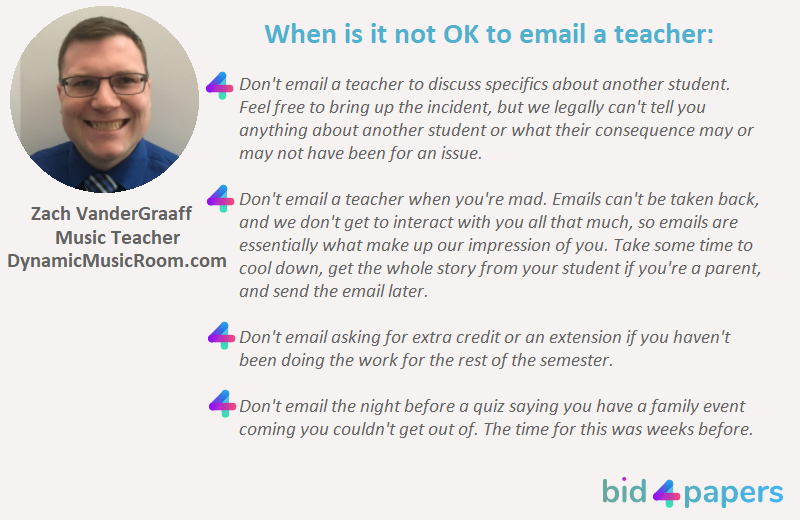
Rachel Coleman, Independent Education Consultant at CollegeEssayEditor.com, adds:
“Every teacher will set different standards for their relationship with their students. Some are more formal; others are more informal. The rule is to let the teacher define the boundaries and abide by them. If your teacher gives out her cell phone at the beginning of the year and says, “Text me if you need help on your assignments,” then you can assume texting is OK. If a teacher says, “Please only email me with the following questions: confusion about a homework assignment or grade, needing to miss class, requests for a letter of recommendation,” then it’s crucial to stay within the parameters of this instruction. But never assume! When in doubt, ask!”
Best Time to Email a Teacher
Zach also admits that emailing any time is OK, as long as you understand a teacher has boundaries too and can’t respond right away:
“During the day, we have some time to send quick, short emails, but for the most part, we’re too busy teaching to respond with emails that require an in-depth answer. Want to increase the chances of getting a quicker turnaround? Then stick to the morning before school or toward the end of the afternoon. Most teachers do some emailing when they first get there and at the end of the day.”
Surveys confirm:
Teachers are more likely to open emails in the morning, between 7 am and 11 am, and then in the late afternoon, between 3 pm and 5 pm, when students have left school. So if you want to get a reply asap, organize your sending time accordingly.
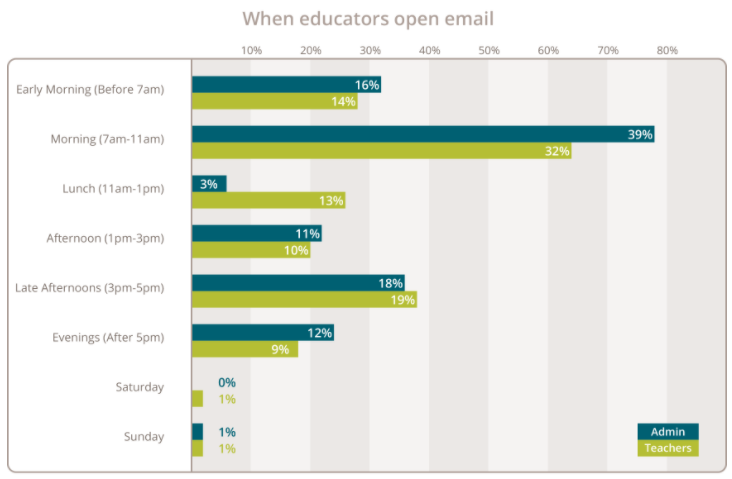
Source: Agile Education Marketing
Please avoid emailing teachers on weekends or holidays. Plus, it’s wrong to spam your teacher’s inbox when they don’t reply after hours.
Remember that teachers don’t spend all of their time at school. It’s best not to email them outside of their working hours. When you respect their personal life, they’ll be glad to help you as much as possible. For time-sensitive questions, don’t send emails less than 24 hours before you need a reply.
So, here’s a recap:
- Try not to email a teacher on weekends and holidays.
- Send your email during a teacher’s working hours.
- Don’t expect an immediate response: give them 1-3 days for a reply.
- Avoid spamming a teacher’s inbox every second hour; respect their time.
- Keep timing in mind when emailing on time-sensitive issues.
How to Start an Email to a Teacher
Two issues to consider here are your email’s subject line and the way you greet a teacher. It’s the first thing they see besides your name, so it’s critical to follow a few rules.
Subject Lines
The #1 rule: Make your email subject line as clear as possible.
Teachers have dozens of students and receive dozens of emails. The detailed subject line will help them understand who you are, what you want, and how time-urgent your message is.
No-no subject line examples:
- Homework question
- Assignment query
- Answer asap, please
- I’ll be absent tomorrow
Strong subject line examples:
- CHEM 112: Question about a lab on Monday
- Class meeting on Tuesday: 9:30 am
- Citation page for coursework: APA or MLA to use?
- Class 23: Confirming thesis for the assigned paper
They communicate the point to a teacher and help distinguish your email from colleagues, administrators, and other students. Plus, these subject lines are short and clear: They make a teacher understand the topic and urgency of your message.
Rebecca Rogers, School Teacher, author of this super cool TikTok account, confirms:
“I tell my students to make sure the subject line tells me what their email will be about because that will tell me how quickly I need to open that particular email. For example, if I have 20 emails to go through, I am more likely to open one with some urgency in the subject line first because I assume it needs my immediate attention. PLEASE DO NOT TYPE YOUR ENTIRE MESSAGE IN THE SUBJECT LINE! PLEASE! I AM BEGGING YOU.”
Her colleague Jessica Robinson, Educator and Content Creator for The Speaking Polymath, suggests students include their names in email subject lines:
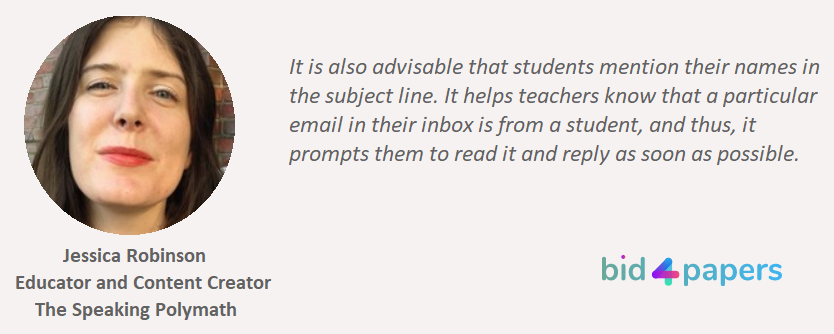
Other indicators such as the title of your class or the date of upcoming meeting can be helpful too. Consider examples like these:
- John Doe, class 42 – Question about research paper
- Tom Smith – Query regarding assignment on Geometry
- Biology 201: On the submission for Lab 3
- Lisa Martin: On upcoming meeting on Wednesday, 11 am
So, here goes a recap:
When emailing teachers, make your subject line short (less than ten words) and clear. Be as specific as possible: A teacher should understand at once who’s emailing and what’s the concern. Include your name and class to help a teacher identify you among dozens of other students.
Greetings
The general rule here: Be polite and formal.
- Start with “Dear Dr./Mr./Mrs./Ms. Last Name” if you never met a teacher before or it’s the way you refer to them in class.
- Feel free to start with “Hello” or “Good morning/afternoon,” but make sure to personalize your greeting with names.
- Double-check the spelling of a teacher’s name. If in doubt, consider a school website, a faculty directory, or a syllabus to make sure you address a teacher correctly.
- Don’t be over casual, avoid greetings like “Hey” or “What’s up,” and try not to call a teacher by their first name unless it’s how you refer to them in lessons.
Rebecca nails it:

Long story short, consider your relationship with a teacher and the expectations of your institution. Refer to educators in the same way you refer to them in lessons. When emailing a teacher from different schools or colleges, please do your best to address them formally.
How to Write an Email Body
When emailing a teacher, some students forget about structuring the email body right. When sending a complete essay or any other assignment, it’s especially true: Students attach a file and click Send without adding any text to the email body.
It’s wrong!
Please always include a message in your email. Not only does it help a teacher understand the context of your message, but it’s also a sign of your good manners and respect.
Here’s how to write an email to a teacher, its body in particular.
Email Structure and Format
Remember that teachers are busy, so make the email body as short and straightforward as possible:
The ideal variant would be to keep it to five sentences or fewer. If that’s impossible, make sure to use short paragraphs and bullet points — therefore, your email will be quicker to scan. Yet, try to be concise and keep the email body fewer than 150 words. If you can’t express your message in 100-150 words, then maybe it would be better to email a teacher about a meeting in person.
Your email to a teacher is not a narrative or personal essay, so please avoid a flair of creativity. Stay concise and formal. Keep a single idea to one paragraph, and break them up for better readability. As Will Peach, medical school student and education blogger behind WillPeachMD.com, says:
“Don’t make your email an unsightly block of text (trust me, no teacher enjoys deciphering these).”
Speaking of formatting your email, please use standard fonts and text colors. Bold, italic, or underlined texts are OK if they help you convey a message or highlight crucial information (data, time, etc.), but say no to flashy fonts (those too large or too stylish) and rainbow text colors. Have mercy upon a teacher’s eyes!
That’s what Janice Wald, Teacher and Blogging Coach behind Mostly Blogging, recommends writing in email bodies:
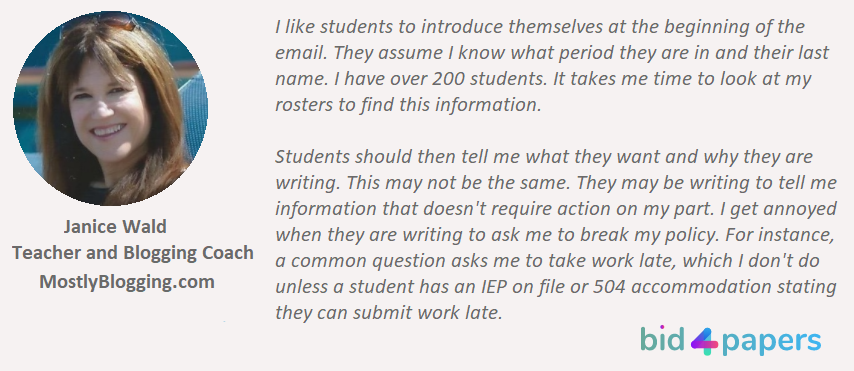
Here goes an example of how to email a teacher:
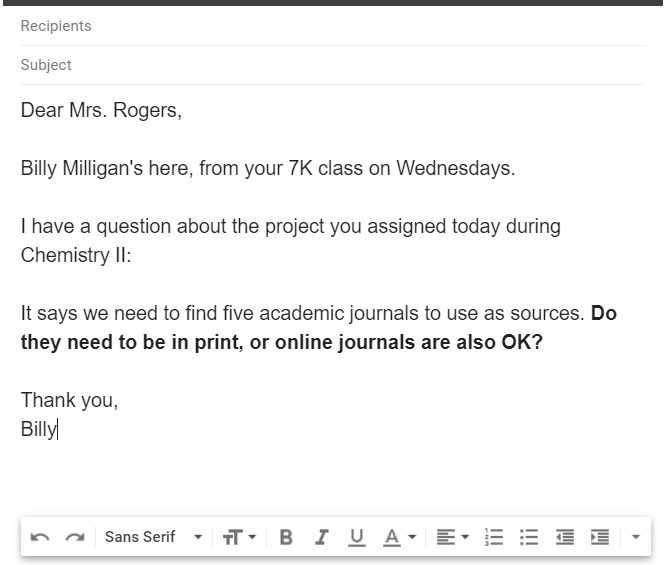
Your Tone of Voice
Being straightforward in emails doesn’t mean being sniveling or extra apologetic. When emailing a teacher, please keep your tone respectful.
- Avoid complaints about how much you dislike an assignment or how unfair a deadline is.
- No smileys or emojis — it’s OK to keep an email controversial, but it needs to be up-to-point.
- Avoid super long explanations, cliché statements like “I hope my email finds you well,” and saying how you’re sorry about disturbing a teacher. Be direct to the point.
Example:
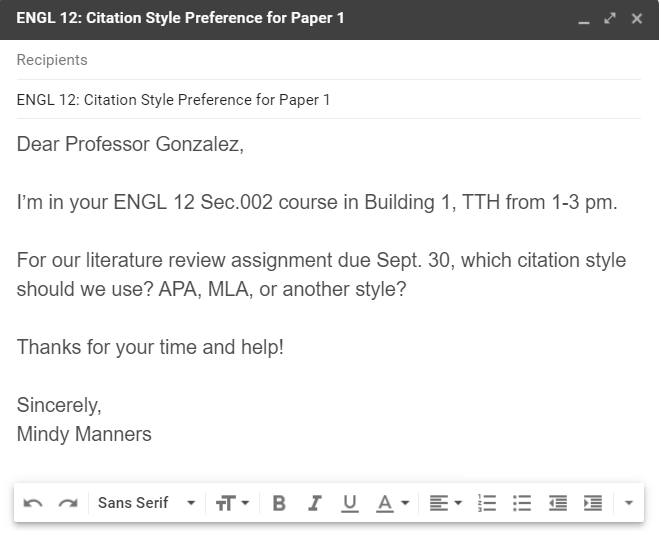
Here’s a practical tip:
Write a draft of your email in Microsoft Word or any other word processing software, not in the email program (Gmail, Outlook, or whatever you use). It will allow you to avoid grammar and spelling mistakes, as well as accidentally hitting Send before you’ve finished and proofread your email.
Attachments
Emails to teachers often involve sending different attachments (complete assignments, tests, applications, etc.). If that’s your case, please follow a few rules:
- Do not attach files with no explanations. In the email body, provide specific details about what you send and why. (Example: “As you requested, I attach my critical essay here because I’ll be absent in class next Monday.”)
- Make sure to name your attached files appropriately. Include your name, class, the name of your assignment, and its number (or due date) if possible.
How to End an Email to a Teacher
Some students believe they don’t need to close an email because their names are evident in their email addresses. However, it’s a writing etiquette and your chance to add a personal touch to your formal email and show respect most teachers appreciate.
So, close your emails to teachers with courtesy.
First, sum your email up in one final sentence to spark a faster response. Consider variants like:
- Thanks in advance for your reply.
- I’ll look forward to your reply regarding my thesis statement.
- I will wait for your response before sending the complete test.
Second, remember to show gratitude and thank your teacher even before they respond. Phrases like “Thank you for your time” or “Thank you a lot for your help” positively influence how a teacher digests your information and regards you as a student.
And third, try to use formal closing lines. “All the best,” “Sincerely,” “Best regards,” or “Best” followed by your full name are great options to consider. Please avoid closings like “Cheers,” “Thanks,” or “See you tomorrow:” They are too casual for these reasons.
Schoolteacher Rebecca Rogers suggests:

Practical Tips on How to Email a Professor
Now that you know how to write an email to a teacher, here goes a quick recap:

You can also try to improve your email and teachers’ expectations even more with the following practical tips:
- Email a teacher only if you can’t find the necessary information in your class syllabus, school website, etc. Check all the options first; maybe you don’t need to write that email at all.
- Use a teacher’s school email address. It’s more professional, allowing them to keep all the correspondence with students in one place.
- Keep your email short and up-to-point.
- Remember about a proper greeting and closing.
- Draft your emails in a word document to avoid accidental sending. When finished and ready, copy-paste your message to the email program.
- Proofread and edit your email if necessary. Make sure to avoid spelling, grammar, and punctuation mistakes.
- Check the tone of your email. Stay formal.
- For complicated questions you can’t format into a 100-word email, it’s better to ask a teacher for an in-person meeting during their office hours.
Eric Kim, Co-Founder at LA Tutors, sums it up:
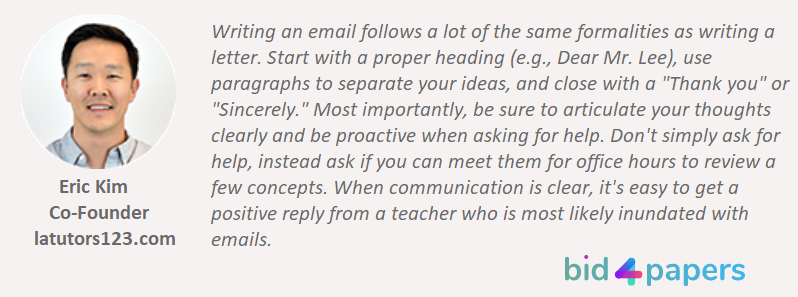
Don’ts of How to Email a Teacher
- Don’t email with questions you can ask in a class tomorrow. Respect a teacher’s time and privacy.
- Avoid colloquial or disrespecting language, common jokes, and personal topics.
- Don’t email a teacher with super time-sensitive questions. It may take them 1-3 days to reply, so keep timing in mind.
- Avoid slang, jargon, abbreviations, and emojis.
- Try to avoid contradictions in your email.
- Don’t write emails in CAPS.
- Say no to stylish fonts, super large or small font size, and bright text colors.
Faisal Nasim, Director of Exam Papers Plus, adds:
“The ONLY time you should email your teacher is if they have given you a school email account. If you’ve found a personal email address for them by some other means, do NOT email that account.”
- Don’t email to complain about other students or ask for extra credit.
- Avoid writing when you are sad or mad, and don’t use multiple exclamation marks.
- Don’t use textual language in emails.
- Never email teachers for purposes other than school-related. Avoid personal topics.
How to Write an Email to a Teacher: Templates
Below are a few templates (samples) you can use for writing emails to teachers. But before sending, make sure to customize and personalize them accordingly.
When asking a question:

When asking for a recommendation:
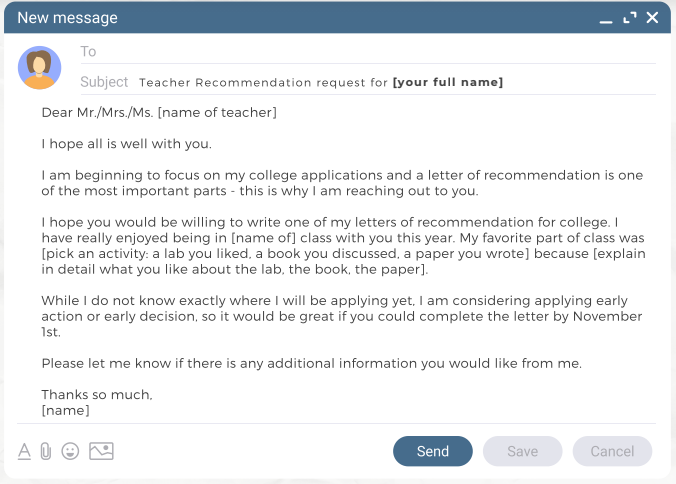
P.S. This template comes from Kate Sonnenberg, Tutor at KS College Success. Thanks for sharing, Kate!
If you need to ask for an appointment:

When you need to inform about your absence in class:

Following up with a teacher who hasn’t respond to your email yet:

Any questions or concerns left on how to write an email to a teacher? Feel free to ask our team for professional writing or editing help!